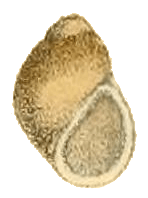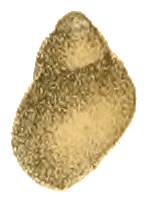Pachydrobiella brevis
Pachydrobiella brevis is a species of freshwater snail, an aquatic gastropod mollusk in the family Pomatiopsidae.
| Pachydrobiella brevis | |
|---|---|
 | |
| Drawing of apertural view of the shell of Pachydrobiella brevis | |
| Scientific classification | |
| Kingdom: | |
| Phylum: | |
| Class: | |
| (unranked): | |
| Superfamily: | |
| Family: | |
| Subfamily: | |
| Tribe: | Jullieniini[1] |
| Genus: | Pachydrobiella |
| Species: | P. brevis |
| Binomial name | |
| Pachydrobiella brevis | |
| Synonyms[1] | |
|
Pachydrobia brevis Bavay, 1895 | |
Pachydrobiella brevis is the only species in the genus Pachydrobiella.[1]
Distribution
The distribution of Pachydrobiella brevis includes Khong Island in the Mekong River, southern Laos.[1] The type locality is Khong Island.[1] This species is probably endemic to the Khong Island region.[1]

Description
The shape of the shell is ovate-conic.[1] The shell is thick and smooth.[1] The smooth shell is unique in the tribe Jullieniini.[1] The outer lip is thick with growth lines.[1]
The width of the shell is 2.5 mm.[3] The height of the shell is 2.2–3.6 mm.[1]
Thiele (1928)[2] and Brandt (1970) made a drawing showing smooth teeth in the radula, but Davis (1979) showed multiserrate teeth in the radula.[1]
Ecology
Pachydrobiella brevis lives primarily in freshwater habitats that lack a current or have only a slight current.[1] However this species sometimes or rarely also lives also in places where the current is moderate or strong all the way to whitewater.[1]
This snail probably feeds on algae on stones.[1]
References
- Davis G. M. (1979). "The origin and evolution of the gastropod family Pomatiopsidae, with emphasis on the Mekong river Triculinae". Academy of natural Sciences of Philadelphia, Monograph 20: 1-120. ISBN 978-1-4223-1926-0.
- Thiele (1928). Zool. Jahrb., Syst. 55: 379.
- Bavay A. (1895). "Coquilles nouvelles, provenant de récoltes de M. L. Levay, dans les rapides de Haut-Mékong, pendant la campagne du Massie, 1893-1894-1895". Journal de Conchyliologie 43: 82-94. Plates 5-6.
External links
| Wikimedia Commons has media related to Pachydrobiella brevis. |